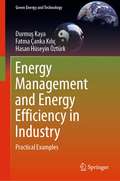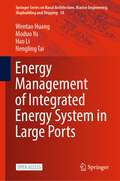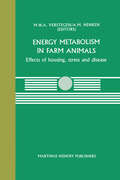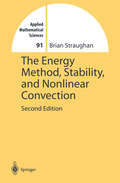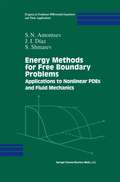- Table View
- List View
Energy Management and Efficiency for the Process Industries
by Alan P. Rossiter Beth P. JonesProvides a unique overview of energy management for the process industries Provides an overall approach to energy management and places the technical issues that drive energy efficiency in context Combines the perspectives of freewheeling consultants and corporate insiders In two sections, the book provides the organizational framework (Section 1) within which the technical aspects of energy management, described in Section 2, can be most effectively executed Includes success stories from three very different companies that have achieved excellence in their energy management efforts Covers energy management, including the role of the energy manager, designing and implementing energy management programs, energy benchmarking, reporting, and energy management systems Technical topics cover efficiency improvement opportunities in a wide range of utility systems and process equipment types, as well as techniques to improve process design and operation
Energy Management and Efficiency for the Process Industries
by Alan P. Rossiter Beth P. JonesProvides a unique overview of energy management for the process industries Provides an overall approach to energy management and places the technical issues that drive energy efficiency in context Combines the perspectives of freewheeling consultants and corporate insiders In two sections, the book provides the organizational framework (Section 1) within which the technical aspects of energy management, described in Section 2, can be most effectively executed Includes success stories from three very different companies that have achieved excellence in their energy management efforts Covers energy management, including the role of the energy manager, designing and implementing energy management programs, energy benchmarking, reporting, and energy management systems Technical topics cover efficiency improvement opportunities in a wide range of utility systems and process equipment types, as well as techniques to improve process design and operation
Energy Management and Energy Efficiency in Industry: Practical Examples (Green Energy and Technology)
by Durmuş Kaya Fatma Çanka Kılıç Hasan Hüseyin ÖztürkThis book is presented to demonstrate how energy efficiency can be achieved in existing systems or in the design of a new system, as well as a guide for energy savings opportunities. Accordingly, the content of the book has been enriched with many examples applied in the industry. Thus, it is aimed to provide energy savings by successfully managing the energy in the readers’ own businesses. The authors primarily present the necessary measurement techniques and measurement tools to be used for energy saving, as well as how to evaluate the methods that can be used for improvements in systems. The book also provides information on how to calculate the investments to be made for these necessary improvements and the payback periods. The book covers topics such as: • Reducing unit production costs by ensuring the reduction of energy costs, • Efficient and quality energy use, • Meeting market needs while maintaining competitive conditions, • Ensuring the protection of the environment by reducing CO2 and CO emissions with energy saving and energy efficiency, • Ensuring the correct usage of systems by carrying out energy audits. In summary, this book explains how to effectively design energy systems and manage energy to increase energy savings. In addition, the study has been strengthened by giving some case studies and their results in the fields of intensive energy consumption in industry. This book is an ideal resource for practitioners, engineers, researchers, academics, employees and investors in the fields of energy, energy management, energy efficiency and energy saving.
Energy Management in Buildings Using Photovoltaics (Green Energy and Technology)
by Elena PapadopoulouAlthough fossil fuels remain the primary global energy source, developing and expanding economies are creating an ever-widening gap between supply and demand. Efficient energy management offers a cost-effective opportunity for both industrialized and developing nations to limit the enormous financial and environmental costs associated with burning fossil fuels. The implication of photovoltaic systems in particular presents the potential for clean and sustainable electrical energy to be generated from an unrestricted source. Energy Management in Buildings Using Photovoltaics demonstrates how adopting ‘best practices’ for energy management and harvesting can reduce the need to construct new generating facilities. Illustrated with figures, tables and photos, Energy Management in Buildings Using Photovoltaics provides an introduction and step by step instructions on designing and planning photovoltaic systems and energy policies for both residential and industrial buildings. With particular focus on the example of provided by European industry, the creation of energy efficient systems is explored including chapters on: Zero Energy Buildings, Photovoltaics Technology, and Connection of the NetworkBy presenting this topic from basic introduction to highly technical analysis, Energy Management in Buildings Using Photovoltaics acts a study guide for postgraduate students as well as a key point of reference for researchers and technical consultants in the field of photovoltaic systems.
Energy Management in Illuminating Systems
by Kao ChenAs our dependence on and need for abundant energy grows, it becomes increasingly important for engineers and managers to develop and maintain energy efficient systems and build effective energy management programs. Energy Management in Illuminating Systems presents the latest concepts, innovative methods, and state-of-the art technologies in commercial or industrial lighting systems and energy management.An effective energy management program comprises three essential elements: organization, technology, and economics. However, the success of any management program clearly must begin with an energy effective illuminating system, which in turn depends upon using sound engineering analysis and design principles during the projects early stages. In this book, the author-with long and unique experience in the field-provides the details of proven methods for achieving these goals. He presents:How to organize and operate the illumination energy management programThe elements of designing energy effective illuminating systems-systems that can also increase worker productivity and reduce operating costsThe latest in efficient system components, including light sources, ballasts, and luminairesHow to evaluate energy efficiency, including discussion of the impact of energy efficient equipment on power quality, harmonics, the ""K"" factor, and lighting energy standards Energy Management in Illuminating Systems shows how to design and manage energy effective lighting systems for industrial or commercial facilities. With this book, designers, engineers, and managers finally have a complete, how-to guide for applying practical energy management principles to various systems of illumination.
Energy Management in Illuminating Systems
by Kao ChenAs our dependence on and need for abundant energy grows, it becomes increasingly important for engineers and managers to develop and maintain energy efficient systems and build effective energy management programs. Energy Management in Illuminating Systems presents the latest concepts, innovative methods, and state-of-the art technologies in commercial or industrial lighting systems and energy management.An effective energy management program comprises three essential elements: organization, technology, and economics. However, the success of any management program clearly must begin with an energy effective illuminating system, which in turn depends upon using sound engineering analysis and design principles during the projects early stages. In this book, the author-with long and unique experience in the field-provides the details of proven methods for achieving these goals. He presents:How to organize and operate the illumination energy management programThe elements of designing energy effective illuminating systems-systems that can also increase worker productivity and reduce operating costsThe latest in efficient system components, including light sources, ballasts, and luminairesHow to evaluate energy efficiency, including discussion of the impact of energy efficient equipment on power quality, harmonics, the ""K"" factor, and lighting energy standards Energy Management in Illuminating Systems shows how to design and manage energy effective lighting systems for industrial or commercial facilities. With this book, designers, engineers, and managers finally have a complete, how-to guide for applying practical energy management principles to various systems of illumination.
Energy Management of Integrated Energy System in Large Ports (Springer Series on Naval Architecture, Marine Engineering, Shipbuilding and Shipping #18)
by Wentao Huang Moduo Yu Hao Li Nengling TaiThis open access book provides a detailed exploration of energy management in seaport integrated energy systems, highlighting their potential to replace conventional fuel-based energy usage and promote sustainable development of large ports. In order to achieve carbon neutrality, energy management technologies are crucial for the sustainable development of port systems that couple energies, logistics, and maritime transportation. Research on seaport integrated energy systems has attracted scholars and scientists from various disciplines, such as port electrification, logistics, microgrids, renewable energies, energy storages, and port automation. Taking a holistic approach, this book establishes a fundamental framework for the topic and discusses the electrification process, coupling mechanisms and modeling, optimal planning, low-carbon and economic operation, as well as applications of integrated energy systems in seaports. This book is intended for researchers, graduate students, and other readers interested in green seaport energy management and low-carbon operation technologies under the coupling between logistics and multi-energy systems.
Energy Management Strategies for Electric and Plug-in Hybrid Electric Vehicles
by Sheldon S. WilliamsonThis book addresses the practical issues for commercialization of current and future electric and plug-in hybrid electric vehicles (EVs/PHEVs). The volume focuses on power electronics and motor drives based solutions for both current as well as future EV/PHEV technologies. Propulsion system requirements and motor sizing for EVs is also discussed, along with practical system sizing examples. PHEV power system architectures are discussed in detail. Key EV battery technologies are explained as well as corresponding battery management issues are summarized. Advanced power electronic converter topologies for current and future charging infrastructures will also be discussed in detail. EV/PHEV interface with renewable energy is discussed in detail, with practical examples.
Energy Markets and Responsive Grids: Modeling, Control, and Optimization (The IMA Volumes in Mathematics and its Applications #162)
by Sean Meyn Tariq Samad Ian Hiskens Jakob StoustrupThis volume consists of selected essays by participants of the workshop Control at Large Scales: Energy Markets and Responsive Grids held at the Institute for Mathematics and its Applications, Minneapolis, Minnesota, U.S.A. from May 9-13, 2016. The workshop brought together a diverse group of experts to discuss current and future challenges in energy markets and controls, along with potential solutions. The volume includes chapters on significant challenges in the design of markets and incentives, integration of renewable energy and energy storage, risk management and resilience, and distributed and multi-scale optimization and control. Contributors include leading experts from academia and industry in power systems and markets as well as control science and engineering. This volume will be of use to experts and newcomers interested in all aspects of the challenges facing the creation of a more sustainable electricity infrastructure, in areas such as distributed and stochastic optimization and control, stability theory, economics, policy, and financial mathematics, as well as in all aspects of power system operation.
Energy Master Planning toward Net Zero Energy Resilient Public Communities Guide
by Alexander ZhivovBest practices from around the world have proven that holistic Energy Master Planning can be the key to identifying cost-effective solutions for energy systems that depend on climate zone, density of energy users, and local resources. Energy Master Planning can be applied to various scales of communities, e.g., to a group of buildings, a campus, a city, a region, or even an entire nation.Although the integration of the energy master planning into the community master planning process may be a challenging task, it also provides significant opportunities to support energy efficiency and community resilience by increasing budgets for investments derived from energy savings, by providing more resilient and cost-effective systems, by increasing comfort and quality of life, and by stimulating local production, which boosts local economies.The Guide is designed to provide a valuable information resource for those involved in community planning: energy systems engineers, architects, energy managers, and building operators. Specifically, this Guide was developed to support the application of the Energy Master Planning process through the lens of best practices and lessons learned from case studies from around the globe. The Guide introduces concepts and metrics for energy system resilience methodologies, and discusses business and financial models for Energy Master Plans implementation. This information can help planners to establish objectives and constraints for energy planning and to select and apply available technologies and energy system architectures applicable to their diverse local energy supply and demand situations.This Guide is a result of research conducted under the International Energy Agency (IEA) Energy in Buildings and Communities (EBC) Program Annex 73 and the US Department of Defense Environmental Security Technology Certification Program (ESTCP) project EW18-5281 to support the planning of Low Energy Resilient Public Communities process that is easy to understand and execute.
Energy Materials: A Short Introduction to Functional Materials for Energy Conversion and Storage
by Aliaksandr S. BandarenkaEnergy Materials: A Short Introduction to Functional Materials for Energy Conversion and Storage provides readers with an accessible overview of the functional materials currently employed or investigated for energy provision, conversion, and storage. Rather than exploring the physical and chemical basics of energy conversion and storage, this book focuses on the various materials used in this field with simple explanations of their design principles, specific functionality, and quantitative figures of merit. It is suited for advanced undergraduate and graduate students studying energy and energy materials in physics, material science, engineering, and chemistry courses, as well as scientists starting their research in the field of functional materials for energy applications. Key Features: Provides an accessible introduction to complex subjects in simple terms with pedagogical features to enhance learning Contains the latest developments in this exciting and growing area Discusses examples from modern high-impact research and applications
Energy Materials: A Short Introduction to Functional Materials for Energy Conversion and Storage
by Aliaksandr S. BandarenkaEnergy Materials: A Short Introduction to Functional Materials for Energy Conversion and Storage provides readers with an accessible overview of the functional materials currently employed or investigated for energy provision, conversion, and storage. Rather than exploring the physical and chemical basics of energy conversion and storage, this book focuses on the various materials used in this field with simple explanations of their design principles, specific functionality, and quantitative figures of merit. It is suited for advanced undergraduate and graduate students studying energy and energy materials in physics, material science, engineering, and chemistry courses, as well as scientists starting their research in the field of functional materials for energy applications. Key Features: Provides an accessible introduction to complex subjects in simple terms with pedagogical features to enhance learning Contains the latest developments in this exciting and growing area Discusses examples from modern high-impact research and applications
Energy Materials: A Circular Economy Approach (Emerging Materials and Technologies)
by Surinder Singh Suresh Sundaramurthy Alex Ibhadon Faisal Khan Sushil Kumar Kansal S. K. MehtaEnergy Materials: A Circular Economy Approach emphasizes the engineering scalability of a circular economy approach to development and use of energy materials. It focuses on waste minimization and its valorization, recycling and reuse, and emerging sustainable materials and technologies. It offers a view of the eco-friendly energy materials and state-of-the-art technologies required for production of these materials in the process industry and manufacturing sectors.• Covers fundamentals, concepts, and current initiatives within the circular economy• Outlines technologies and materials with specific applications for energy systems, sustainability aspects and societal benefits• Focuses on detailed aspects of processing of energy materials, kinetics, their utilization, and end-of-life management and application of circular economy in waste utilization and valorization• Discusses technologies, processing methods, and production of materials related to fuel cells, super capacitors and battery materials, carbon based hetrostructures, catalysis, functional materials, nanotechnology, biofuels, solar and wind energy, and valuable chemicals• Details topics related to synthesis and application of energy materials, their recycle, reuse, and life cycleThis book is aimed at students, researchers and professional engineers and scientists working in chemical, materials, energy, and environmental engineering, as well as materials chemistry.
Energy Materials: A Circular Economy Approach (Emerging Materials and Technologies)
Energy Materials: A Circular Economy Approach emphasizes the engineering scalability of a circular economy approach to development and use of energy materials. It focuses on waste minimization and its valorization, recycling and reuse, and emerging sustainable materials and technologies. It offers a view of the eco-friendly energy materials and state-of-the-art technologies required for production of these materials in the process industry and manufacturing sectors.• Covers fundamentals, concepts, and current initiatives within the circular economy• Outlines technologies and materials with specific applications for energy systems, sustainability aspects and societal benefits• Focuses on detailed aspects of processing of energy materials, kinetics, their utilization, and end-of-life management and application of circular economy in waste utilization and valorization• Discusses technologies, processing methods, and production of materials related to fuel cells, super capacitors and battery materials, carbon based hetrostructures, catalysis, functional materials, nanotechnology, biofuels, solar and wind energy, and valuable chemicals• Details topics related to synthesis and application of energy materials, their recycle, reuse, and life cycleThis book is aimed at students, researchers and professional engineers and scientists working in chemical, materials, energy, and environmental engineering, as well as materials chemistry.
Energy Metabolism in Farm Animals: Effects of housing, stress and disease (Current Topics in Veterinary Medicine #44)
by M. W. A. Verstegen and A. M. HenkenAnimal production systems have changed dramatically over the last two decades. Knowledge of energy metabolism and environmental physio logy has increased as appears from many textbooks on these disciplines. The contents of the symposia on energy metabolism of farm animals show this and they have initially focussed on feed evaluation and later on com parative aspects of energy metabolism. They show part of the progress being made. Application of knowledge of energy metabolism for animals has a long history since Lavoisier. In addition to this, studies about the environ mental requirements of animals have shown that we are still far from ac curate assessment of these requirements in terms of nutrients and ener gy. I n model studies on energy metabolism researchers have recognized the interaction between the environment and the energy requirements of animals. Estimation of energy requirements has been done in physiolo gical, physical and behavioural studies. The impact of conditions as en countered by animals in various production systems has been approached from different viewpoints related to these different disciplines. In addi tion, various kinds of infections (bacterial, parasitic: subclinical, clini cal) have been evaluated only recently with regard to their effect on pro tein and/or energy metabolism and thus on production. People working in the field of feed evaluation have defined how che mical and physical properties of nutrition infiuence energy to be derived for maintenance and production.
Energy Metabolism in Insects
by Roger G. DownerThe scientific program for the XVI International Congress of Entomology, held in Kyoto, Japan August 3-9, 1980 included a symposium on the subject of "Energy Metabolism and Its Regulation in Insects." The symposium provided an opportunity to integrate knowledge, and focus attention, on an important and fundamental aspect of insect biochemis try/physiology. The energy metabolism of insects differs from that of other animals in a variety of ways, including the prodigious amounts of energy expended by flying insects, the presence in hemolymph of large concentrations of sugar in the form of the nonreducing disaccharide tre halose, the transport of fat in the form of diacylglycerol, and the periodic mobilization and deposition of cuticular components during development. These differences, together with hormones, neurohormones, and neu rotransmitters that are specific to (or functionally different in) insects, serve to demonstrate the unique nature of energy metabolism in insects. An obvious corollary from the demonstrated uniqueness of insect energy metabolism is that an understanding of the process may lead to the de velopment of new, specific agents or strategies for the suppression of insect pests. The present volume is an expanded version of the Kyoto symposium.
Energy Metabolism in Trauma (Novartis Foundation Symposia)
by Julie Knight Ruth PorterThe Novartis Foundation Series is a popular collection of the proceedings from Novartis Foundation Symposia, in which groups of leading scientists from a range of topics across biology, chemistry and medicine assembled to present papers and discuss results. The Novartis Foundation, originally known as the Ciba Foundation, is well known to scientists and clinicians around the world.
The Energy Method, Stability, and Nonlinear Convection (Applied Mathematical Sciences #91)
by Brian StraughanSix new chapters (14-19) deal with topics of current interest: multi-component convection diffusion, convection in a compressible fluid, convenction with temperature dependent viscosity and thermal conductivity, penetrative convection, nonlinear stability in ocean circulation models, and numerical solution of eigenvalue problems.
The Energy Method, Stability, and Nonlinear Convection (Applied Mathematical Sciences #91)
by Brian StraughanSix new chapters (14-19) deal with topics of current interest: multi-component convection diffusion, convection in a compressible fluid, convenction with temperature dependent viscosity and thermal conductivity, penetrative convection, nonlinear stability in ocean circulation models, and numerical solution of eigenvalue problems.
Energy Methods for Free Boundary Problems: Applications to Nonlinear PDEs and Fluid Mechanics (Progress in Nonlinear Differential Equations and Their Applications #48)
by S.N. Antontsev J.I. Diaz S. ShmarevFor the past several decades, the study of free boundary problems has been a very active subject of research occurring in a variety of applied sciences. What these problems have in common is their formulation in terms of suitably posed initial and boundary value problems for nonlinear partial differential equations. Such problems arise, for example, in the mathematical treatment of the processes of heat conduction, filtration through porous media, flows of non-Newtonian fluids, boundary layers, chemical reactions, semiconductors, and so on. The growing interest in these problems is reflected by the series of meetings held under the title "Free Boundary Problems: Theory and Applications" (Ox ford 1974, Pavia 1979, Durham 1978, Montecatini 1981, Maubuisson 1984, Irsee 1987, Montreal 1990, Toledo 1993, Zakopane 1995, Crete 1997, Chiba 1999). From the proceedings of these meetings, we can learn about the different kinds of mathematical areas that fall within the scope of free boundary problems. It is worth mentioning that the European Science Foundation supported a vast research project on free boundary problems from 1993 until 1999. The recent creation of the specialized journal Interfaces and Free Boundaries: Modeling, Analysis and Computation gives us an idea of the vitality of the subject and its present state of development. This book is a result of collaboration among the authors over the last 15 years.
Energy Methods in Continuum Mechanics: Proceedings of the Workshop on Energy Methods for Free Boundary Problems in Continuum Mechanics, held in Oviedo, Spain, March 21–23, 1994
by S. N. Antontsev J. I. Díaz S. I. ShmarevThis volume contains the proceedings of the Workshop Energy Methods for Free Boundary Problems in Continuum Mechanics, held in Oviedo, Spain, from March 21 to March 23, 1994. It is well known that the conservation laws and the constitutive equations of Continuum Mechanics lead to complicated coupled systems of partial differential equations to which, as a rule, one fails to apply the techniques usually employed in the studies of scalar uncoupled equations such as, for instance, the maximum principle. The study of the qualitative behaviour of solutions of the systems re quires different techniques, among others, the so called, Energy Methods where the properties of some integral of a nonnegative function of one or several unknowns allow one to arrive at important conclusions on the envolved unknowns. This vol ume presents the state of the art in such a technique. A special attention is paid to the class of Free Boundary Problems. The organizers are pleased to thank the European Science Foundation (Pro gram on Mathematical treatment of free boundary problems), the DGICYT (Spain), the FICYT (Principado de Asturias, Spain) and the Universities of Oviedo and Complutense de Madrid for their generous financial support. Finally, we wish to thank Kluwer Academic Publishers for the facilities received for the publication of these Proceedings.
Energy Methods in Dynamics (Interaction of Mechanics and Mathematics)
by Khanh Chau Le Lu Trong NguyenEnergy Methods in Dynamics is a textbook based on the lectures given by the first author at Ruhr University Bochum, Germany. Its aim is to help students acquire both a good grasp of the first principles from which the governing equations can be derived, and the adequate mathematical methods for their solving. Its distinctive features, as seen from the title, lie in the systematic and intensive use of Hamilton's variational principle and its generalizations for deriving the governing equations of conservative and dissipative mechanical systems, and also in providing the direct variational-asymptotic analysis, whenever available, of the energy and dissipation for the solution of these equations. It demonstrates that many well-known methods in dynamics like those of Lindstedt-Poincare, Bogoliubov-Mitropolsky, Kolmogorov-Arnold-Moser (KAM), Wentzel–Kramers–Brillouin (WKB), and Whitham are derivable from this variational-asymptotic analysis.This second edition includes the solutions to all exercises as well as some new materials concerning amplitude and slope modulations of nonlinear dispersive waves.
Energy Minimization Methods in Computer Vision and Pattern Recognition: Second International Workshop, EMMCVPR'99, York, UK, July 26-29, 1999, Proceedings (Lecture Notes in Computer Science #1654)
by Edwin R. Hancock Marcello PelilloThe Energy Mix for Sustaining Our Future: Selected Papers from Proceedings of Energy and Sustainability 2018 (Springer Proceedings in Energy)
by Ahmad Vasel David S.-K. TingThis book gathers the proceedings of the Energy and Sustainability 2018 Symposium (EAS 2018) held in Windsor, Canada in June 2018. It brings together the state-of-the-art on specific aspects of the current energy status, and covers a wide range of energy and engineering systems, from internal combustion engines to electric vehicles, from the atmosphere, solar and wind, to underground geothermal and underwater turbines and energy storage. The book demonstrates how conventional internal combustion engines have advanced dramatically in terms of both performance and emissions over the past century. It also studies how life-supporting elements, such as water and greenhouses, must be prioritized and protected to ensure a sustainable future. The book offers a valuable source of information for future leaders, engineers, environmentalists, social forerunners, and decision-makers alike. It also provides a reference guide for both undergraduate and graduate students in engineering, the natural and social sciences, business and economics.
Energy Modeling: Art Science Practice (Routledge Revivals)
by Milton F. SearlIn 1973, a seminar was held by Resources for the Future to bring together the new and growing community of scholars researching into the general field of energy modelling. Originally published in the same year, this report gathers together all of the papers presented at that seminar in order to further spread the results of these studies with those who were unable to attend. The papers cover a full range of techniques used for energy modelling whilst commenting on current government and industry models. This title will be of interest to students of Environmental Studies.

